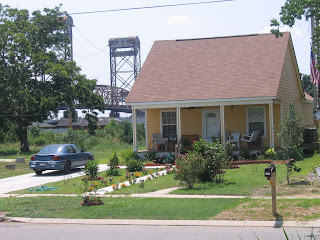Star Power Helps Residents Return Home
We all remember seeing people rescued from rooftops, homes destroyed beyond recognition, heartbreaking cries for help and the appalling response from the federal government, in the days shortly after Hurricane Katrina. So as New Orleans continues its long road to recovery, why would anyone return to the city, especially to the Lower 9th Ward? Questioning a 9th Ward resident’s motives and desires to return irritates Melba Leggett-Barnes. “I hear people say that and I tell them to mind their business,” Leggett-Barnes says, with an air of aggravation in her voice.
The 52-year-old is one of what can be called “the lucky 13.” Leggett-Barnes lost her that was footsteps away from one of the levees breached by Hurricane Katrina. Four years later, help from a Hollywood A-list star has erased the heartache and frustration that consumed every minute of Leggett-Barnes’ day, as she tried for three years to make North Carolina home. “At first, I wasn’t planning on coming back because there was nothing to come back to,” says Leggett-Barnes.
Today, in the 1700 block of Tennessee Street, she comes home to something new and unlike anything ever seen in the Lower 9th Ward. Leggett-Barnes lives in a single-family home that’s solar-powered, built about 7 feet above the ground and can withstand Hurricane-force winds up to 130mph. “I love it and I feel truly blessed,” she says. Leggett-Barnes’ home and 12 others are the first completed of 150 energy-efficient homes slated to line the streets of the Lower 9th Ward. The “Make It Right Foundation,” founded by actor Brad Pitt partners with contractors to build the homes. Pitt wanted to ensure barriers like affordable and safe housing would not continue to keep 9th Ward residents locked out of the city.
The “Make It Right” homes cost about $150,000. According to the foundation, half of the cost is covered by various grants and loans, homeowners are responsible for the other half. Sixty-five additional families are in the final stages of purchasing their return home through the program.
By some estimates Hurricane Katrina wiped out 275,000 homes in New Orleans. A little more than 25 percent of residents are back in major parts of the city. In the Lower 9th Ward, an estimated 19 percent of the 7,000 families that called the neighborhood home have returned. Contractor Stevie Jenkins of New Look Builders has built at least 11 conventional single-family homes in the neighborhood. At the end of November, he’s closing his 10-year-old business and relocating to Texas. Jenkins says he can no longer financially maintain his homebuilding business in New Orleans. “I anticipated a much faster recovery process for people coming back but the red tape is terrible and some homeowners who planned to come back to the 9th Ward have spent everything they saved,” says Jenkins. “The area is hurting,” he adds.
Unfinished business is probably the best way to describe the hurt you see and feel as you walk through the neighborhood. If you drive through and carefully navigate the pot-hole streets, that cause you to zigzag at a sluggish pace , there’s no way to ignore the numerous eyesores. For every new home like Leggett-Barnes on the block, you can count at least five empty lots. One is directly across the street from her new home. Four concrete steps lead to nothing but a lot full of dry, brown grass, evidence that a home was once in that spot.
Basic services, businesses and anchors like churches, schools and health clinics are essentially still absent. There’s only one beauty salon, no fire station, less than a handful of gas stations and bus service is sporadic. The Dr. Martin Luther King, Jr. Charter School for Science and Technology is the only school open. Prior to Katrina, there were four schools serving thousands of children in the neighborhood.
The Army Corps of Engineers’ repair work on levees breached by Hurricane Katrina isn’t exactly comforting to residents. Despite the Corps’ assurances that the levees are safe, there’s still an air of apprehension and skepticism in the Lower 9th Ward. “I got the best house on the block because it’s made of steel and will sway from side to side if the levee breaks again,” says Leggett-Barnes.
What she and returning residents who live in their new homes also have is an emotional void filled and the weight of instability lifted. Every day they walk up the steps and open the door to a place many of us take for granted, home.
Please forward all comments and suggestions regarding this article to newsheels@gmail.com or post your comments on the blog site.






dear moniko, i love the piece you wrote on us, ttese words you have written we shall chrish forever. thank-you for choosing us.
ReplyDelete